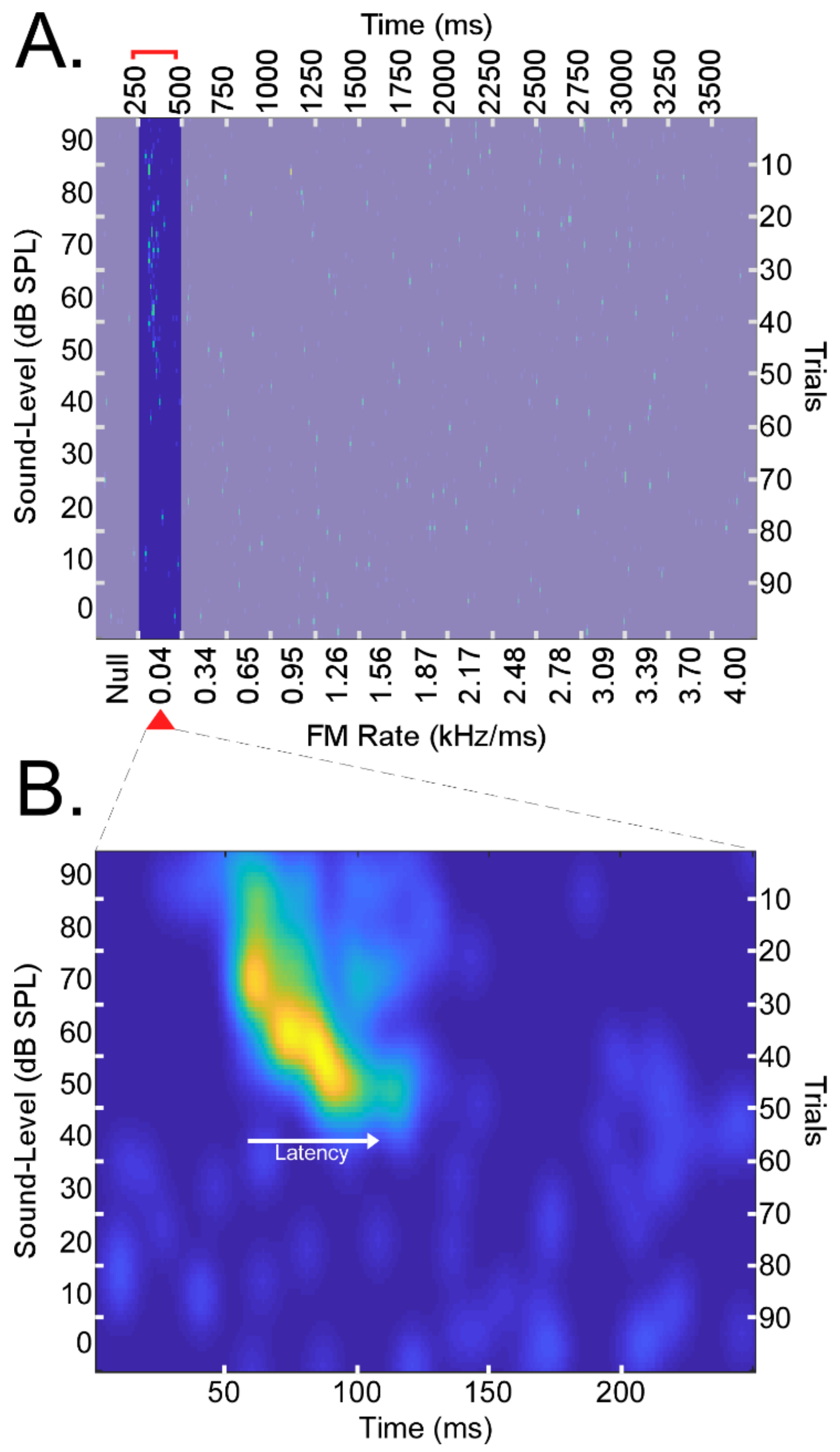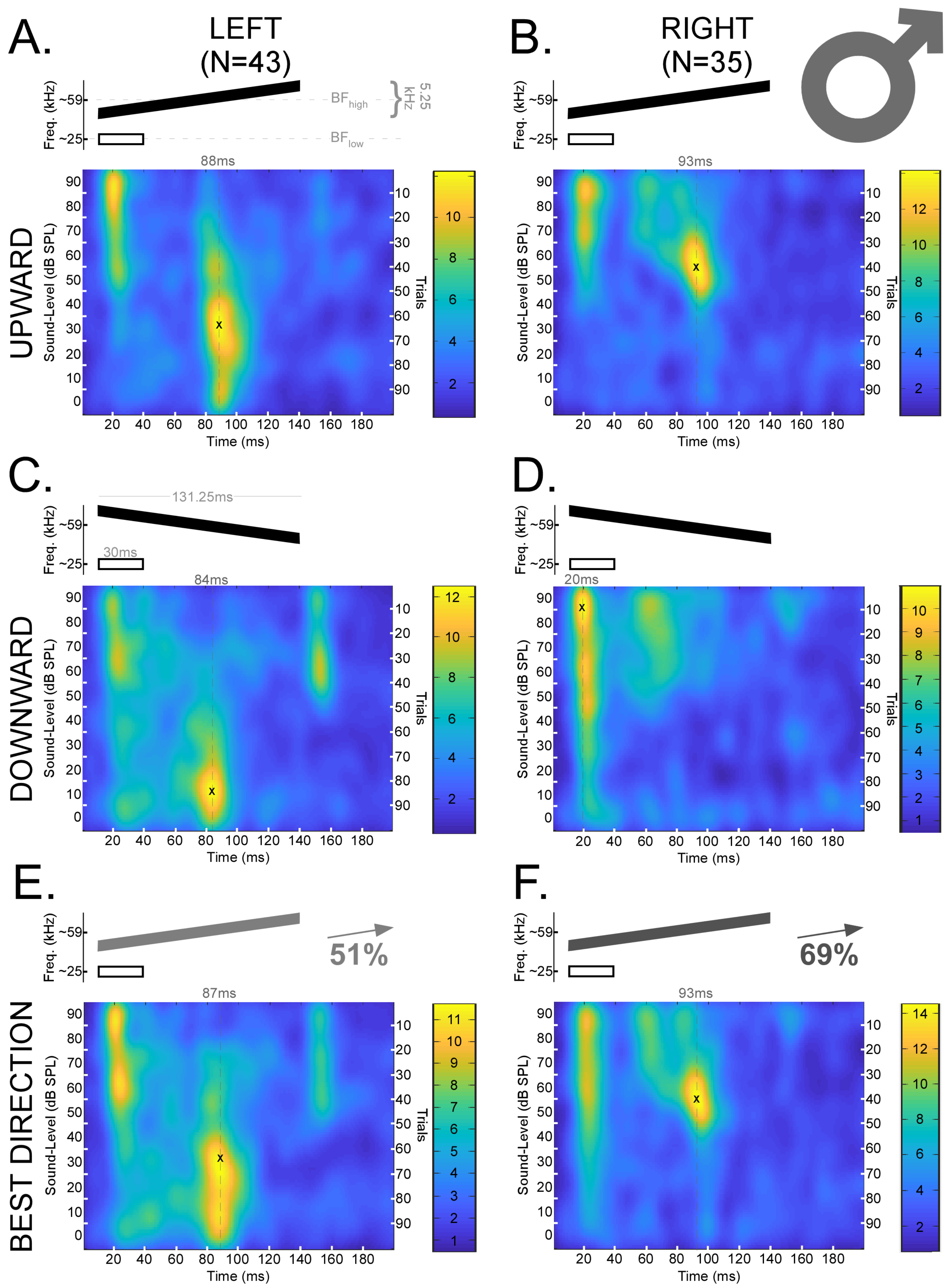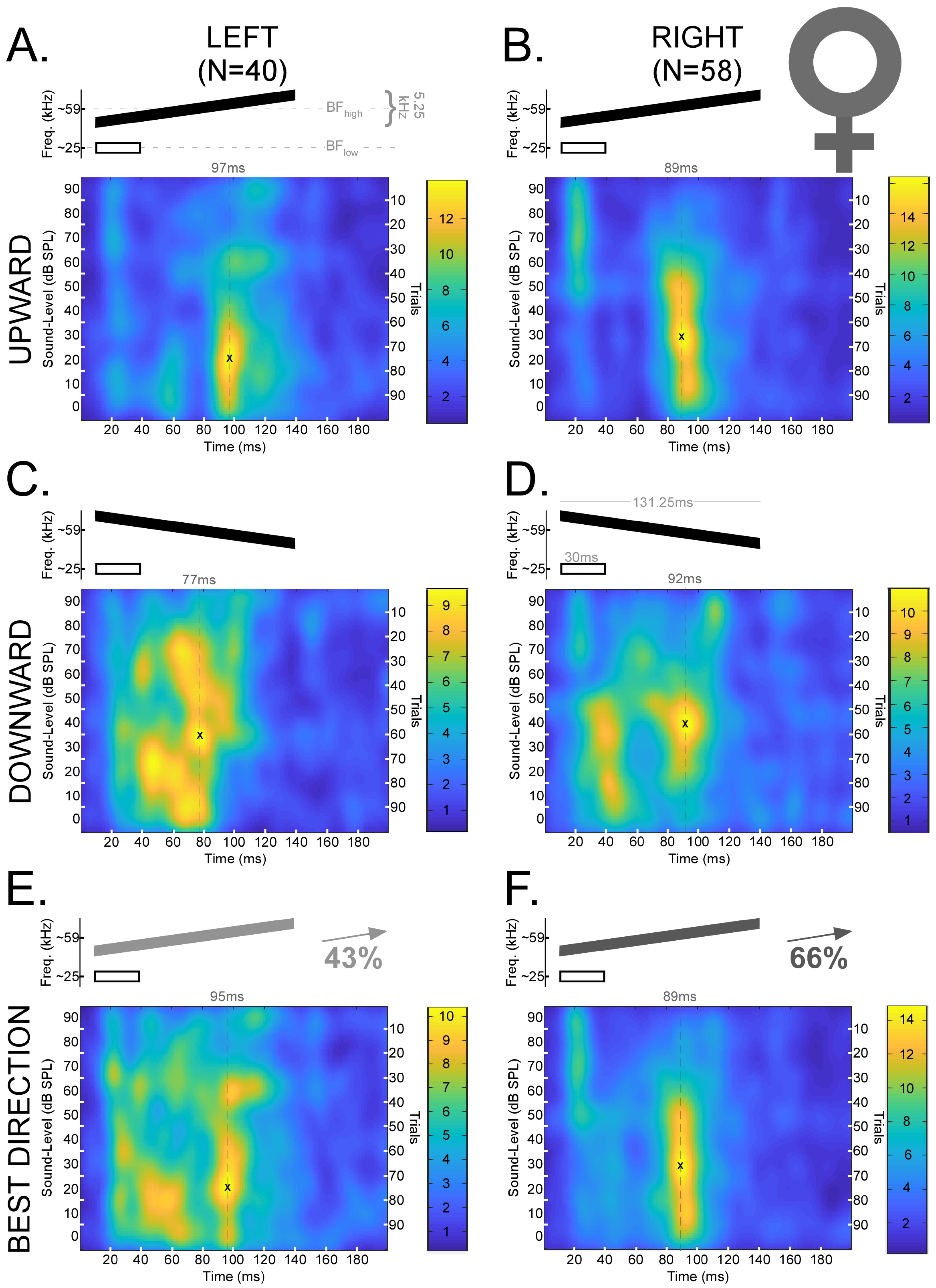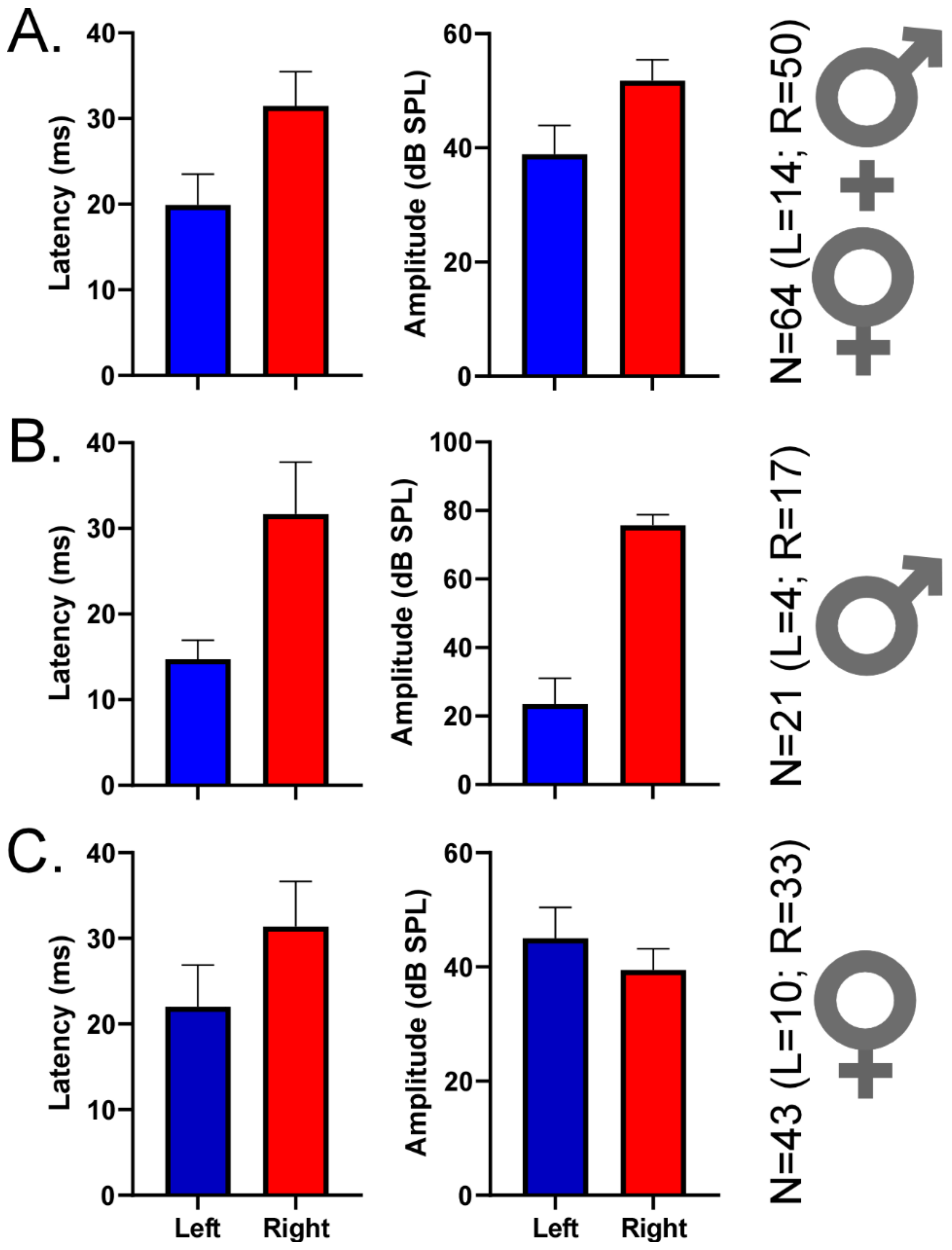Hemispheric and Sex Differences in Mustached Bat Primary Auditory Cortex Revealed by Neural Responses to Slow Frequency Modulations
Abstract
1. Introduction
2. Methods
2.1. Surgery and Electrophysiological Recordings
2.2. Acoustic Stimuli
2.3. Data Analysis
3. Results
4. Discussion
Author Contributions
Funding
Data Availability Statement
Acknowledgments
Conflicts of Interest
References
- Wernicke, K. Der Aphasische Symptomencomplex: Eine Psychologische Studie auf Anatomischer Basis Breslau; Crohn, M., Ed.; Cohn Weigert: Breslau, Poland, 1874; Available online: https://wellcomecollection.org/works/dwv5w9rw (accessed on 15 February 2021).
- Robson, H.; Sage, K.; Ralph, M.A.L. Wernicke’s aphasia reflects a combination of acoustic-phonological and semantic control deficits: A case-series comparison of Wernicke’s aphasia, semantic dementia and semantic aphasia. Neuropsychologia 2012, 50, 266–275. [Google Scholar] [CrossRef]
- Belin, P.; Zilbovicius, M.; Crozier, S.; Thivard, L.; Fontaine, A.A.; Masure, M.-C.; Samson, Y. Lateralization of Speech and Auditory Temporal Processing. J. Cogn. Neurosci. 1998, 10, 536–540. [Google Scholar] [CrossRef]
- Mäkelä, A.M.; Alku, P.; May, P.; Mäkinen, V.; Tiitinen, H. Left-hemispheric brain activity reflects formant transitions in speech sounds. Neuro Rep. 2005, 16, 549–553. [Google Scholar] [CrossRef]
- Schwartz, J.; Tallal, P. Rate of acoustic change may underlie hemispheric specialization for speech perception. Science 1980, 207, 1380–1381. [Google Scholar] [CrossRef] [PubMed]
- Flinker, A.; Doyle, W.K.; Mehta, A.D.; Devinsky, O.; Poeppel, D. Spectrotemporal modulation provides a unifying framework for auditory cortical asymmetries. Nat. Hum. Behav. 2019, 3, 393–405. [Google Scholar] [CrossRef] [PubMed]
- Boemio, A.; Fromm, S.J.; Braun, A.R.; Poeppel, D. Hierarchical and asymmetric temporal sensitivity in human auditory cortices. Nat. Neurosci. 2005, 8, 389–395. [Google Scholar] [CrossRef] [PubMed]
- Schönwiesner, M.; Rübsamen, R.; Von Cramon, D.Y. Hemispheric asymmetry for spectral and temporal processing in the human antero-lateral auditory belt cortex. Eur. J. Neurosci. 2005, 22, 1521–1528. [Google Scholar] [CrossRef] [PubMed]
- Brown, C.P.; Fitch, R.H.; Tallal, P. Sex and Hemispheric Differences for Rapid Auditory Processing in Normal Adults. Laterality Asymmetries Body Brain Cogn. 1999, 4, 39–50. [Google Scholar] [CrossRef] [PubMed]
- Divenyi, P.L.; Robinson, A.J. Nonlinguistic auditory capabilities in aphasia. Brain Lang. 1989, 37, 290–326. [Google Scholar] [CrossRef]
- Merzenich, M.M.; Jenkins, W.M.; Johnston, P.; Schreiner, C.; Miller, S.L.; Tallal, P. Temporal Processing Deficits of Language-Learning Impaired Children Ameliorated by Training. Science 1996, 271, 77–81. [Google Scholar] [CrossRef]
- Tallal, P.; Miller, S.; Fitch, R.H. Neurobiological Basis of Speech: A Case for the Preeminence of Temporal Processing. Ann. N. Y. Acad. Sci. 1993, 682, 27–47. [Google Scholar] [CrossRef] [PubMed]
- Temple, E.; Poldrack, R.A.; Protopapas, A.; Nagarajan, S.; Salz, T.; Tallal, P.; Merzenich, M.M.; Gabrieli, J.D.E. Disruption of the neural response to rapid acoustic stimuli in dyslexia: Evidence from functional MRI. Proc. Natl. Acad. Sci. USA 2000, 97, 13907–13912. [Google Scholar] [CrossRef] [PubMed]
- Robin, D.A.; Tranel, D.; Damasio, H. Auditory perception of temporal and spectral events in patients with focal left and right cerebral lesions. Brain Lang. 1990, 39, 539–555. [Google Scholar] [CrossRef]
- Efron, R. Temporal Perception, Aphasia and D’ej’a Vu. Brain 1963, 86, 403–424. [Google Scholar] [CrossRef]
- Jamison, H.L.; Watkins, K.E.; Bishop, D.; Matthews, P.M. Hemispheric Specialization for Processing Auditory Nonspeech Stimuli. Cereb. Cortex 2005, 16, 1266–1275. [Google Scholar] [CrossRef]
- Zatorre, R.J.; Belin, P. Spectral and temporal processing in human auditory cortex. Cereb. Cortex 2001, 11, 946–953. [Google Scholar] [CrossRef]
- Sidtis, J.J. On the nature of the cortical function underlying right hemisphere auditory perception. Neuropsychologia 1980, 18, 321–330. [Google Scholar] [CrossRef]
- Sidtis, J.J. The complex tone test: Implications for the assessment of auditory laterality effects. Neuropsychologia 1981, 19, 103–112. [Google Scholar] [CrossRef]
- Samson, S.; Zatorre, R.J. Melodic and harmonic discrimination following unilateral cerebral excision. Brain Cogn. 1988, 7, 348–360. [Google Scholar] [CrossRef]
- Zatorre, R.J. Pitch perception of complex tones and human temporal-lobe function. J. Acoust. Soc. Am. 1988, 84, 566–572. [Google Scholar] [CrossRef]
- Zatorre, R.J. Discrimination and recognition of tonal melodies after unilateral cerebral excisions. Neuropsychologia 1985, 23, 31–41. [Google Scholar] [CrossRef]
- Samson, S.; Zatorre, R.J. Contribution of the right temporal lobe to musical timbre discrimination. Neuropsychologia 1994, 32, 231–240. [Google Scholar] [CrossRef]
- Zatorre, R.J.; Evans, A.C.; Meyer, E. Neural mechanisms underlying melodic perception and memory for pitch. J. Neurosci. 1994, 14, 1908–1919. [Google Scholar] [CrossRef]
- Milner, B. Laterality effects in audition. In Interhemispheric Relations and Cerebral Dominance; Mountcastle, V.B., Ed.; Johns Hopkins Press: Baltimore, MD, USA, 1962; pp. 177–195. [Google Scholar]
- Robinson, T.; Fallside, F. A recurrent error propagation network speech recognition system. Comput. Speech Lang. 1991, 5, 259–274. [Google Scholar] [CrossRef]
- Lakshminarayanan, K.; Ben Shalom, D.; van Wassenhove, V.; Orbelo, D.; Houde, J.; Poeppel, D. The effect of spectral manipulations on the identification of affective and linguistic prosody. Brain Lang. 2003, 84, 250–263. [Google Scholar] [CrossRef]
- Zatorre, R.J.; Belin, P.; Penhune, V.B. Structure and function of auditory cortex: Music and speech. Trends Cogn. Sci. 2002, 6, 37–46. [Google Scholar] [CrossRef]
- Poeppel, D. The analysis of speech in different temporal integration windows: Cerebral lateralization as ‘asymmetric sampling in time’. Speech Commun. 2003, 41, 245–255. [Google Scholar] [CrossRef]
- Joos, M. Acoustic Phonetics; Linguistic Society of America: Baltimore, MD, USA, 1948; 136p. [Google Scholar]
- Schuller, B.; Batliner, A. Computational Paralinguistics: Emotion, Affect and Personality in Speech and Language Processing, 1st ed.; John Wiley and Sons, Ltd.: West Sussex, UK, 2014; p. 344. [Google Scholar]
- Lansdell, H. Sex Differences in Hemispheric Asymmetries of the Human Brain. Nat. Cell Biol. 1964, 203, 550. [Google Scholar] [CrossRef] [PubMed]
- McGlone, J. Sex Differences in the Cerebral Organization of Verbal Functions in Patients with Unilateral Brain Lesions. Brain 1977, 100, 775–793. [Google Scholar] [CrossRef] [PubMed]
- Shaywitz, B.A.; Shaywltz, S.E.; Pugh, K.R.; Constable, R.T.; Skudlarski, P.; Fulbright, R.K.; Bronen, R.A.; Fletcher, J.M.; Shankweiler, D.P.; Katz, L.; et al. Sex differences in the functional organization of the brain for language. Nat. Cell Biol. 1995, 373, 607–609. [Google Scholar] [CrossRef]
- Evans, T.M.; Flowers, D.L.; Napoliello, E.M.; Eden, G.F. Sex-specific gray matter volume differences in females with developmental dyslexia. Brain Struct. Funct. 2013, 219, 1041–1054. [Google Scholar] [CrossRef] [PubMed][Green Version]
- Liberman, A.; Mattingly, I. A specialization for speech perception. Science 1989, 243, 489–494. [Google Scholar] [CrossRef]
- Ringo, J.L.; Doty, R.W.; Demeter, S.; Simard, P.Y. Time Is of the Essence: A Conjecture that Hemispheric Specialization Arises from Interhemispheric Conduction Delay. Cereb. Cortex 1994, 4, 331–343. [Google Scholar] [CrossRef]
- Poremba, A.; Malloy, M.; Saunders, R.C.; Carson, R.E.; Herscovitch, P.; Mishkin, M. Species-specific calls evoke asymmetric activity in the monkey’s temporal poles. Nature 2004, 427, 448–451. [Google Scholar] [CrossRef]
- Heffner, H.E.; Heffner, R.S. Temporal lobe lesions and perception of species-specific vocalizations by Macaques. Science 1984, 226, 75–76. [Google Scholar] [CrossRef] [PubMed]
- Heffner, E.H.; Heffner, R.S.; Hefner, H.E. Effect of unilateral and bilateral auditory cortex lesions on the discrimination of vocalizations by Japanese macaques. J. Neurophysiol. 1986, 56, 683–701. [Google Scholar] [CrossRef]
- Hook, M.; Rogers, L. Lateralized use of the mouth in production of vocalizations by marmosets. Neuropsychologia 1998, 36, 1265–1273. [Google Scholar] [CrossRef]
- Gannon, P.J.; Holloway, R.L.; Broadfield, D.C.; Braun, A.R. Asymmetry of Chimpanzee Planum Temporale: Humanlike Pattern of Wernicke’s Brain Language Area Homolog. Science 1998, 279, 220–222. [Google Scholar] [CrossRef] [PubMed]
- Poremba, A.; Mishkin, M. Exploring the extent and function of higher-order auditory cortex in rhesus monkeys. Hear. Res. 2007, 229, 14–23. [Google Scholar] [CrossRef][Green Version]
- Voss, H.U.; Tabelow, K.; Polzehl, J.; Tchernichovski, O.; Maul, K.K.; Salgado-Commissariat, D.; Ballon, D.; Helekar, S.A. Functional MRI of the zebra finch brain during song stimulation suggests a lateralized response topography. Proc. Natl. Acad. Sci. USA 2007, 104, 10667–10672. [Google Scholar] [CrossRef]
- Poirier, C.; Boumans, T.; Verhoye, M.; Balthazart, J.; Van Der Linden, A. Own-Song Recognition in the Songbird Auditory Pathway: Selectivity and Lateralization. J. Neurosci. 2009, 29, 2252–2258. [Google Scholar] [CrossRef] [PubMed]
- Nottebohm, F.; Arnold, A.P. Sexual dimorphism in vocal control areas of the songbird brain. Science 1976, 194, 211–213. [Google Scholar] [CrossRef] [PubMed]
- DeVoogd, T.J.; Nottebohm, F. Sex differences in dendritic morphology of a song control nucleus in the canary: A quantitative Golgi study. J. Comp. Neurol. 1981, 196, 309–316. [Google Scholar] [CrossRef]
- Phan, M.; Vicario, D.S. Hemispheric differences in processing of vocalizations depend on early experience. Proc. Natl. Acad. Sci. USA 2010, 107, 2301–2306. [Google Scholar] [CrossRef]
- George, I.; Cousillas, H.; Richard, J.-P.; Hausberger, M. State-dependent hemispheric specialization in the songbird brain. J. Comp. Neurol. 2005, 488, 48–60. [Google Scholar] [CrossRef]
- Kanwal, J.S. Right-left asymmetry in the cortical processing of sounds for social communication vs. navigation in mustached bats. Eur. J. Neurosci. 2011, 35, 257–270. [Google Scholar] [CrossRef]
- Ehret, G. Left hemisphere advantage in the mouse brain for recognizing ultrasonic communication calls. Nat. Cell Biol. 1987, 325, 249–251. [Google Scholar] [CrossRef] [PubMed]
- Levy, R.B.; Marquarding, T.; Reid, A.P.; Pun, C.M.; Renier, N.; Oviedo, H.V. Circuit asymmetries underlie functional lateralization in the mouse auditory cortex. Nat. Commun. 2019, 10, 2783. [Google Scholar] [CrossRef] [PubMed]
- Wetzel, W.; Ohl, F.W.; Scheich, H. Global versus local processing of frequency-modulated tones in gerbils: An animal model of lateralized auditory cortex functions. Proc. Natl. Acad. Sci. USA 2008, 105, 6753–6758. [Google Scholar] [CrossRef]
- Güntürkün, O.; Ströckens, F.; Ocklenburg, S. Brain Lateralization: A Comparative Perspective. Physiol. Rev. 2020, 100, 1019–1063. [Google Scholar] [CrossRef]
- Tallal, P. Of bats and men. J. Neurophysiol. 2012, 108, 1545–1547. [Google Scholar] [CrossRef]
- Andics, A.; Miklósi, Á. Neural processes of vocal social perception: Dog-human comparative fMRI studies. Neurosci. Biobehav. Rev. 2018, 85, 54–64. [Google Scholar] [CrossRef] [PubMed]
- Ocklenburg, S.; Ströckens, F.; Güntürkün, O. Lateralisation of conspecific vocalisation in non-human vertebrates. Laterality Asymmetries Body Brain Cogn. 2013, 18, 1–31. [Google Scholar] [CrossRef] [PubMed]
- Boye, M.; Güntürkün, O.; Vauclair, J. Right ear advantage for conspecific calls in adults and subadults, but not infants, California sea lions (Zalophus californianus): Hemispheric specialization for communication? Eur. J. Neurosci. 2005, 21, 1727–1732. [Google Scholar] [CrossRef] [PubMed]
- Bauer, R.H. Lateralization of neural control for vocalization by the frog (Rana pipiens). Psychobiology 1993, 21, 243–248. [Google Scholar] [CrossRef]
- Andics, A.; Gábor, A.; Gácsi, M.; Faragó, T.; Szabó, D.; Miklósi, Á. Neural mechanisms for lexical processing in dogs. Science 2016, 353, 1030–1032. [Google Scholar] [CrossRef]
- Andics, A.; Gácsi, M.; Faragó, T.; Kis, A.; Miklósi, Á. Voice-Sensitive Regions in the Dog and Human Brain Are Revealed by Comparative fMRI. Curr. Biol. 2014, 24, 574–578. [Google Scholar] [CrossRef]
- Siniscalchi, M.; D’Ingeo, S.; Quaranta, A. Lateralized emotional functioning in domestic animals. Appl. Anim. Behav. Sci. 2021, 237, 105282. [Google Scholar] [CrossRef]
- Smith, A.V.; Proops, L.; Grounds, K.; Wathan, J.; Scott, S.K.; McComb, K. Domestic horses (Equus caballus) discriminate between negative and positive human nonverbal vocalisations. Sci. Rep. 2018, 8, 13052. [Google Scholar] [CrossRef]
- Van Ruijssevelt, L.; Washington, S.D.; Hamaide, J.; Verhoye, M.; Keliris, G.A.; Van Der Linden, A. Song Processing in the Zebra Finch Auditory Forebrain Reflects Asymmetric Sensitivity to Temporal and Spectral Structure. Front. Neurosci. 2017, 11, 549. [Google Scholar] [CrossRef]
- Pagliaro, A.H.; Arya, P.; Piristine, H.; Lord, J.S.; Gobes, S.M. Bilateral brain activity in auditory regions is necessary for successful vocal learning in songbirds. Neurosci. Lett. 2020, 718, 134730. [Google Scholar] [CrossRef]
- Fitch, R.H.; Brown, C.P.; O’Connor, K.; Tallal, P. Functional lateralization for auditory temporal processing in male and female rats. Behav. Neurosci. 1993, 107, 844–850. [Google Scholar] [CrossRef] [PubMed]
- Washington, S.D.; Kanwal, J.S. Sex-dependent hemispheric asymmetries for processing frequency-modulated sounds in the primary auditory cortex of the mustached bat. J. Neurophysiol. 2012, 108, 1548–1566. [Google Scholar] [CrossRef] [PubMed]
- Suga, N.; Jen, P. Disproportionate tonotopic representation for processing CF-FM sonar signals in the mustache bat auditory cortex. Science 1976, 194, 542–544. [Google Scholar] [CrossRef] [PubMed]
- Suga, N. The extent to which biosonar information is represented in the bat auditory cortex. In Neurocomputing 2: Directions for Research; Anderson, J.A., Pellionisz, A., Rosenfeld, E., Eds.; MIT Press: Cambridge, MA, USA, 1985; pp. 259–294. [Google Scholar]
- O’Neill, W.; Suga, N. Target range-sensitive neurons in the auditory cortex of the mustache bat. Science 1979, 203, 69–73. [Google Scholar] [CrossRef]
- Suga, N.; O’Neill, W. Neural axis representing target range in the auditory cortex of the mustache bat. Science 1979, 206, 351–353. [Google Scholar] [CrossRef] [PubMed]
- Suga, N. Specialization of the auditory system for the processing of bio-sonar information in the frequency domain: Mustached bats. Hear. Res. 2018, 361, 1–22. [Google Scholar] [CrossRef]
- Xiao, Z.; Suga, N. Reorganization of the cochleotopic map in the bat’s auditory system by inhibition. Proc. Natl. Acad. Sci. USA 2002, 99, 15743–15748. [Google Scholar] [CrossRef]
- Kanwal, J.S.; Fitzpatrick, D.C.; Suga, N. Facilitatory and inhibitory frequency tuning of combination-sensitive neurons in the primary auditory cortex of mustached bats. J. Neurophysiol. 1999, 82, 2327–2345. [Google Scholar] [CrossRef][Green Version]
- Fitzpatrick, D.C.; Kanwal, J.S.; Butman, J.; Suga, N. Combination-sensitive neurons in the primary auditory cortex of the mustached bat. J. Neurosci. 1993, 13, 931–940. [Google Scholar] [CrossRef] [PubMed][Green Version]
- Fitzpatrick, D.C.; Suga, N.; Olsen, J.F. Distribution of response types across entire hemispheres of the mustached bat’s auditory cortex. J. Comp. Neurol. 1998, 391, 353–365. [Google Scholar] [CrossRef]
- Washington, S.D.; Hamaide, J.; Jeurissen, B.; Van Steenkiste, G.; Huysmans, T.; Sijbers, J.; Deleye, S.; Kanwal, J.S.; De Groof, G.; Liang, S.; et al. A three-dimensional digital neurological atlas of the mustached bat (Pteronotus parnellii). NeuroImage 2018, 183, 300–313. [Google Scholar] [CrossRef] [PubMed]
- Esser, K.-H.; Condon, C.J.; Suga, N.; Kanwal, J.S. Syntax processing by auditory cortical neurons in the FM-FM area of the mustached bat Pteronotus parnellii. Proc. Natl. Acad. Sci. USA 1997, 94, 14019–14024. [Google Scholar] [CrossRef]
- Hauser, M.D.; Konishi, M. Processing Species-specific Calls by Combination-sensitive Neurons in an Echolocating Bat. In The Design of Animal Communication; The MIT Press: Cambridge, MA, USA, 2003; pp. 135–157. [Google Scholar]
- Kanwal, J.S. A distributed cortical representation of social communication calls. In Behavior and Neurodynamics for Auditory Communication; Kanwal, J.S., Ehret, G., Eds.; Cambridge University Press: New York, NY, USA, 2006; pp. 156–188. [Google Scholar]
- Medvedev, A.V.; Kanwal, J.S. Local Field Potentials and Spiking Activity in the Primary Auditory Cortex in Response to Social Calls. J. Neurophysiol. 2004, 92, 52–65. [Google Scholar] [CrossRef] [PubMed]
- Washington, S.D.; Kanwal, J.S. DSCF Neurons Within the Primary Auditory Cortex of the Mustached Bat Process Frequency Modulations Present Within Social Calls. J. Neurophysiol. 2008, 100, 3285–3304. [Google Scholar] [CrossRef][Green Version]
- Kanwal, J.S.; Matsumura, S.; Ohlemiller, K.; Suga, N. Analysis of acoustic elements and syntax in communication sounds emitted by mustached bats. J. Acoust. Soc. Am. 1994, 96, 1229–1254. [Google Scholar] [CrossRef]
- Washington, S.D.; Tillinghast, J.S. Conjugating time and frequency: Hemispheric specialization, acoustic uncertainty, and the mustached bat. Front. Neurosci. 2015, 9, 143. [Google Scholar] [CrossRef]
- Clement, M.J.; Gupta, P.; Dietz, N.; Kanwal, J.S. Audiovocal Communication and Social Behavior in Mustached Bats. In Behavior and Neurodynamics for Auditory Communication; Kanwal, J.S., Ehret, G., Eds.; Cambridge University Press: New York, NY, USA, 2006; pp. 57–84. [Google Scholar]
- Washington, S.D.; Kanwal, J.S. Linear FM Synthesis: Test Stimuli for Rapid Analysis of Auditory Neurodynamics. Hoya Tech. Res. Bull. 2004, 2004120, 2004. [Google Scholar]
- Ma, X.; Suga, N. Corticofugal Modulation of the Paradoxical Latency Shifts of Inferior Collicular Neurons. J. Neurophysiol. 2008, 100, 1127–1134. [Google Scholar] [CrossRef][Green Version]
- Ocklenburg, S.; Korte, S.M.; Peterburs, J.; Wolf, O.T.; Güntürkün, O. Stress and laterality—The comparative perspective. Physiol. Behav. 2016, 164, 321–329. [Google Scholar] [CrossRef]
- Cory-Slechta, D.A.; Weston, D.; Liu, S.; Allen, J.L. Brain Hemispheric Differences in the Neurochemical Effects of Lead, Prenatal Stress, and the Combination and Their Amelioration by Behavioral Experience. Toxicol. Sci. 2013, 132, 419–430. [Google Scholar] [CrossRef] [PubMed]
- Wittling, W.; Pflüger, M. Neuroendocrine hemisphere asymmetries: Salivary cortisol secretion during lateralized viewing of emotion-related and neutral films. Brain Cogn. 1990, 14, 243–265. [Google Scholar] [CrossRef]
- Brüne, M.; Nadolny, N.; Güntürkün, O.; Wolf, O.T. Stress induces a functional asymmetry in an emotional attention task. Cogn. Emot. 2013, 27, 558–566. [Google Scholar] [CrossRef] [PubMed]
- Sherwood, C.C.; Raghanti, M.A.; Wenstrup, J.J. Is humanlike cytoarchitectural asymmetry present in another species with complex social vocalization? A stereologic analysis of mustached bat auditory cortex. Brain Res. 2005, 1045, 164–174. [Google Scholar] [CrossRef]
- Suga, N.; O’Neill, W.; Manabe, T. Harmonic-sensitive neurons in the auditory cortex of the mustache bat. Science 1979, 203, 270–274. [Google Scholar] [CrossRef] [PubMed]
- Hsiao, C.J.; Jen, P.H.-S.; Wu, C.-H. The cochlear size of bats and rodents derived from MRI images and histology. Neuro Rep. 2015, 26, 478–482. [Google Scholar] [CrossRef] [PubMed]
- Kamada, K.; Pekar, J.J.; Kanwal, J.S. Anatomical and functional imaging of the auditory cortex in awake mustached bats using magnetic resonance technology. Brain Res. Protoc. 1999, 4, 351–359. [Google Scholar] [CrossRef]





Publisher’s Note: MDPI stays neutral with regard to jurisdictional claims in published maps and institutional affiliations. |
© 2021 by the authors. Licensee MDPI, Basel, Switzerland. This article is an open access article distributed under the terms and conditions of the Creative Commons Attribution (CC BY) license (https://creativecommons.org/licenses/by/4.0/).
Share and Cite
Washington, S.D.; Pritchett, D.L.; Keliris, G.A.; Kanwal, J.S. Hemispheric and Sex Differences in Mustached Bat Primary Auditory Cortex Revealed by Neural Responses to Slow Frequency Modulations. Symmetry 2021, 13, 1037. https://doi.org/10.3390/sym13061037
Washington SD, Pritchett DL, Keliris GA, Kanwal JS. Hemispheric and Sex Differences in Mustached Bat Primary Auditory Cortex Revealed by Neural Responses to Slow Frequency Modulations. Symmetry. 2021; 13(6):1037. https://doi.org/10.3390/sym13061037
Chicago/Turabian StyleWashington, Stuart D., Dominique L. Pritchett, Georgios A. Keliris, and Jagmeet S. Kanwal. 2021. "Hemispheric and Sex Differences in Mustached Bat Primary Auditory Cortex Revealed by Neural Responses to Slow Frequency Modulations" Symmetry 13, no. 6: 1037. https://doi.org/10.3390/sym13061037
APA StyleWashington, S. D., Pritchett, D. L., Keliris, G. A., & Kanwal, J. S. (2021). Hemispheric and Sex Differences in Mustached Bat Primary Auditory Cortex Revealed by Neural Responses to Slow Frequency Modulations. Symmetry, 13(6), 1037. https://doi.org/10.3390/sym13061037





